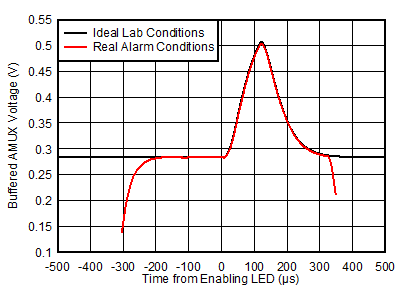SLVAEX3 October 2020 TPS8802 , TPS8804
4.3.5 Real and Ideal System Conditions
SNR measurements taken using laboratory conditions is expected to provide a better SNR than in a real smoke alarm. For this reason, a set of measurements are taken using a 2V power supply, the TPS8802 boost converter, and a MSP430F5529 Launchpad microcontroller to control the TPS8802. The buffered AMUX output is measured using an oscilloscope. Figure 4-18 displays the 100 waveform average of each condition, showing that the pulse shape is nearly identical. The achieved SNR is higher using the real system, shown in Figure 4-19. No SNR disadvantage is observed from enabling and disabling the photo amplifier, AMUX, and boost converter as done in a smoke alarm.

| tLED=100 µs | τ1=30 µs | τ2=30 µs |

| tLED=100 µs | τ1=30 µs | τ2=30 µs |